| Dua Ali
Define Boilerplate
Boilerplate code is a term that's commonly used in the
programming world. It refers to code sections repeated
throughout a program or software. The term "boilerplate"
comes from the printing world, describing the pre-cut
metal plates used to print text repeatedly. In
programming, boilerplate code serves a similar purpose,
saving developers time and effort by providing
pre-written code they can use in their programs.
Have you ever wondered what makes software development
more efficient? How can developers save time and
accelerate the coding process? The answer lies in a
concept called boilerplate code.
Boilerplate code is the backbone of software
development, providing developers with reusable patterns
and standard code structures. But what exactly is
boilerplate code, and how does it streamline the
development process? Let's explore.
So, what is boilerplate code, and how does it contribute to efficient software development?
Key Takeaways:
- Boilerplate code is a set of pre-written and reusable code patterns that streamline software development.
- It helps developers save time by providing default code structures and programming templates.
- Boilerplate code promotes code reusability and acts as a programming shortcut.
- Examples of boilerplate code can be found in various programming languages.
- Writing effective boilerplate code requires following best practices and maintaining code readability.
Understanding Boilerplate Code
In the world of programming, boilerplate code is a term
that holds significant meaning. It refers to sections of
code that are reused in multiple places with little to
no alteration. But what exactly does the term
"boilerplate code" mean? Let's explore its definition
and its crucial role in programming.
Boilerplate code is a term used in programming to refer
to pre-written sections of code that can be reused in
different projects or parts of the same project. This
type of code is used as a foundation or template for
common patterns in software development. Boilerplate
code is essential to the development process, providing
developers with a starting point for writing code
consistently and efficiently. It eliminates the need to
reinvent the wheel for everyday programming tasks,
allowing programmers to focus on the unique aspects of
their projects.
Characteristics of boilerplate code:
- Reusability: Boilerplate code can be reused across different projects or parts of the same project, saving time and effort for developers.
- Standardization: It promotes consistency in coding practices by providing predefined patterns and structures.
- Efficiency: By using boilerplate code, developers can reduce the time and effort required to write repetitive code snippets.
- Readability: Well-written boilerplate code enhances code readability, making it easier for other developers to understand and maintain.
Boilerplate code can also closely relate to programming
templates and common code patterns. Templates are a
basis for creating new files or projects with predefined
structures. On the other hand, common code patterns
refer to frequently recurring sections of code used
across different projects or parts of the same project.
In the next section, we will explore the role of
boilerplate code in streamlining the software
development process. We will examine how it provides
developers with code snippets, standard structures, and
templates that accelerate coding and reduce development
time.
Boilerplate Language Examples
In this blog, demonstration of a small example of a boilerplate code is given below.
- Open VS Code and click on the setting button in the bottom-left corner.
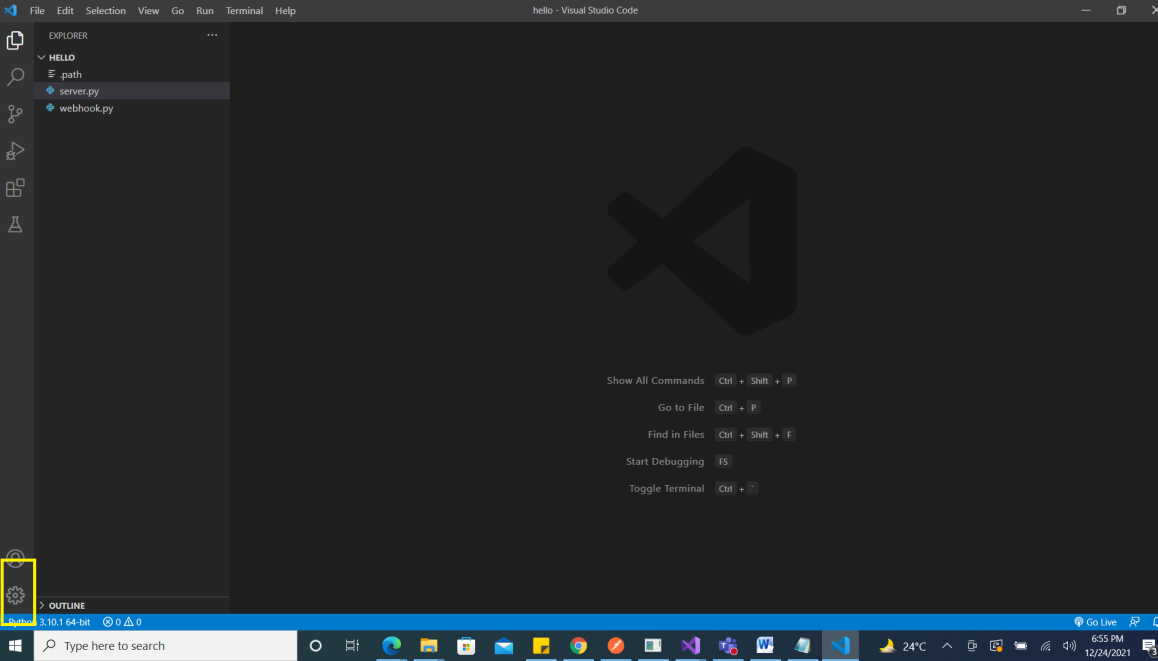
- Click on User Snippets.
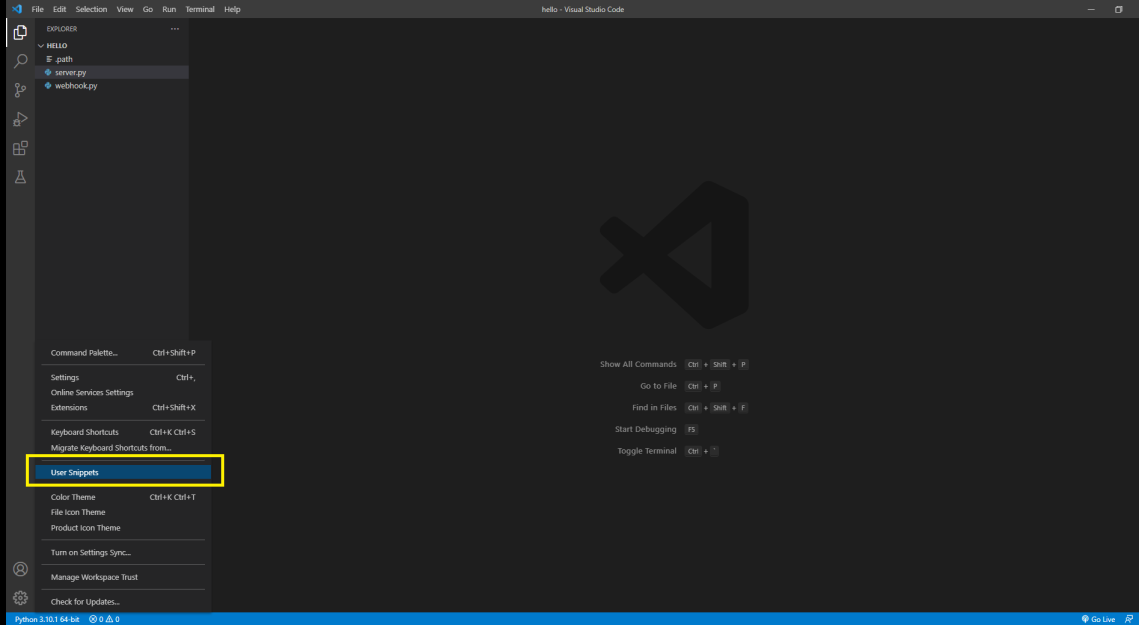
- After clicking on user snippets, a dropdown will appear at the top containing list of JSON files. Click on cpp.json
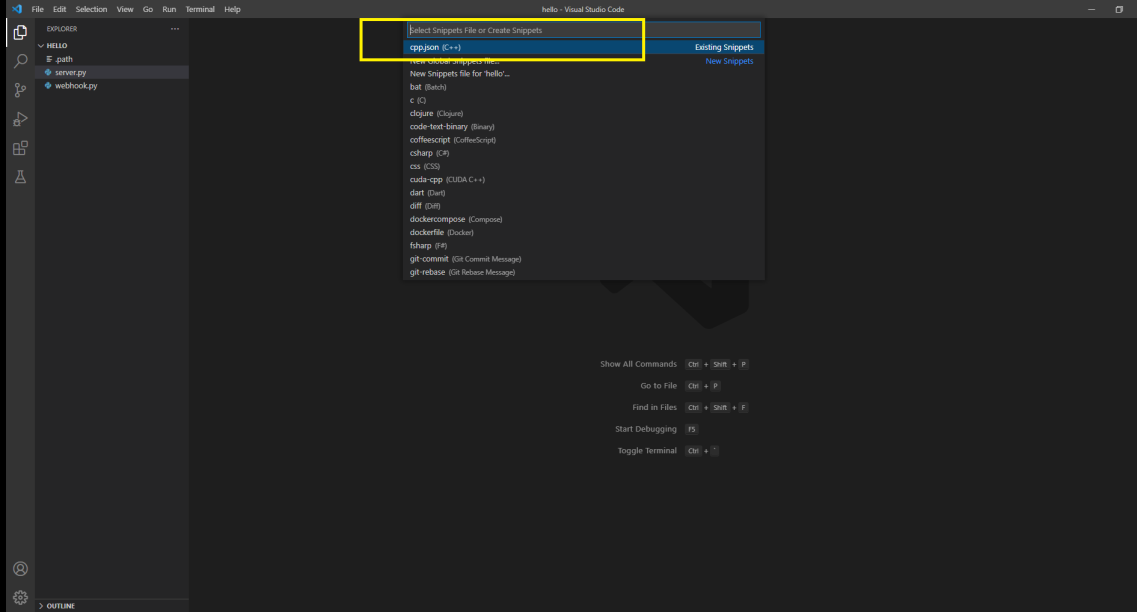
- Add the C++ code to the JSON file as shown below and save the file by pressing CTRL+S.
Explanation of the code:
Prefix: It is used to trigger the boilerplate.
Body: it contains the reusable code, which we will call with the help of prefix.
Description: It contains a small definition of the snippet.
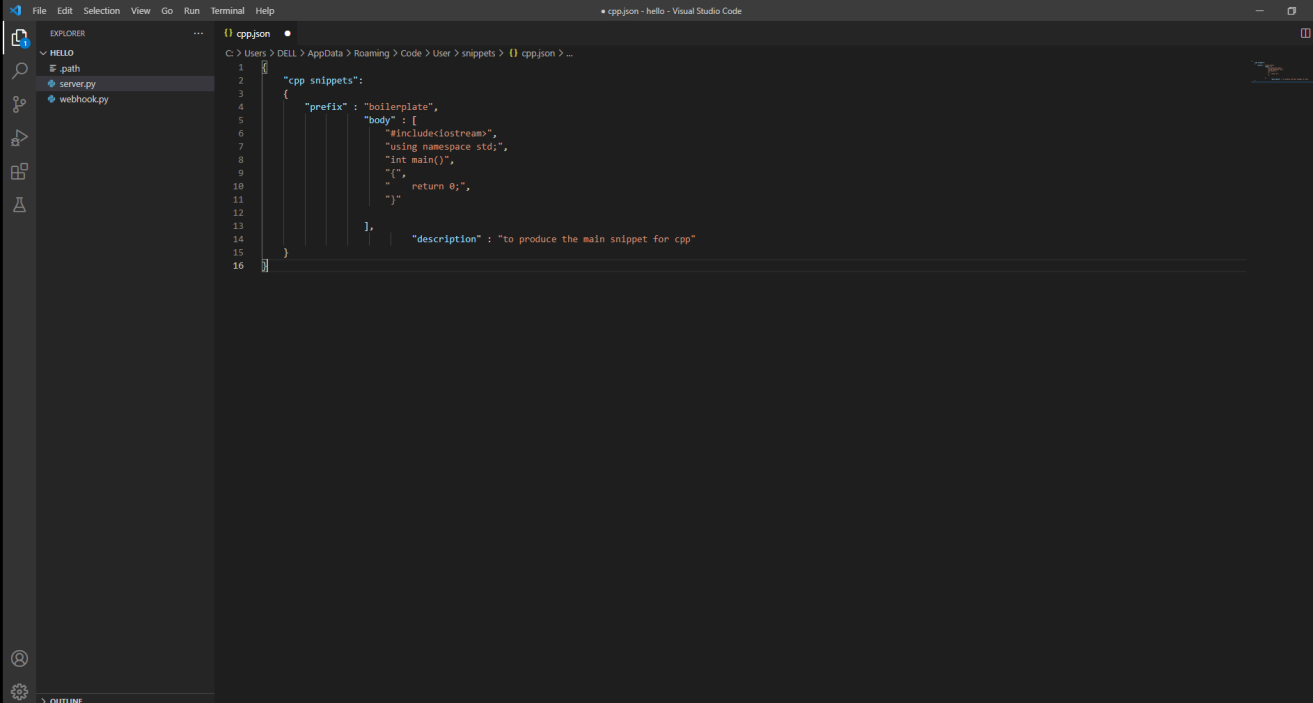
- Create a new C++ file in VS Code in the current folder. Type the prefix which we used for our boilerplate. It will automatically suggest your prefix name.
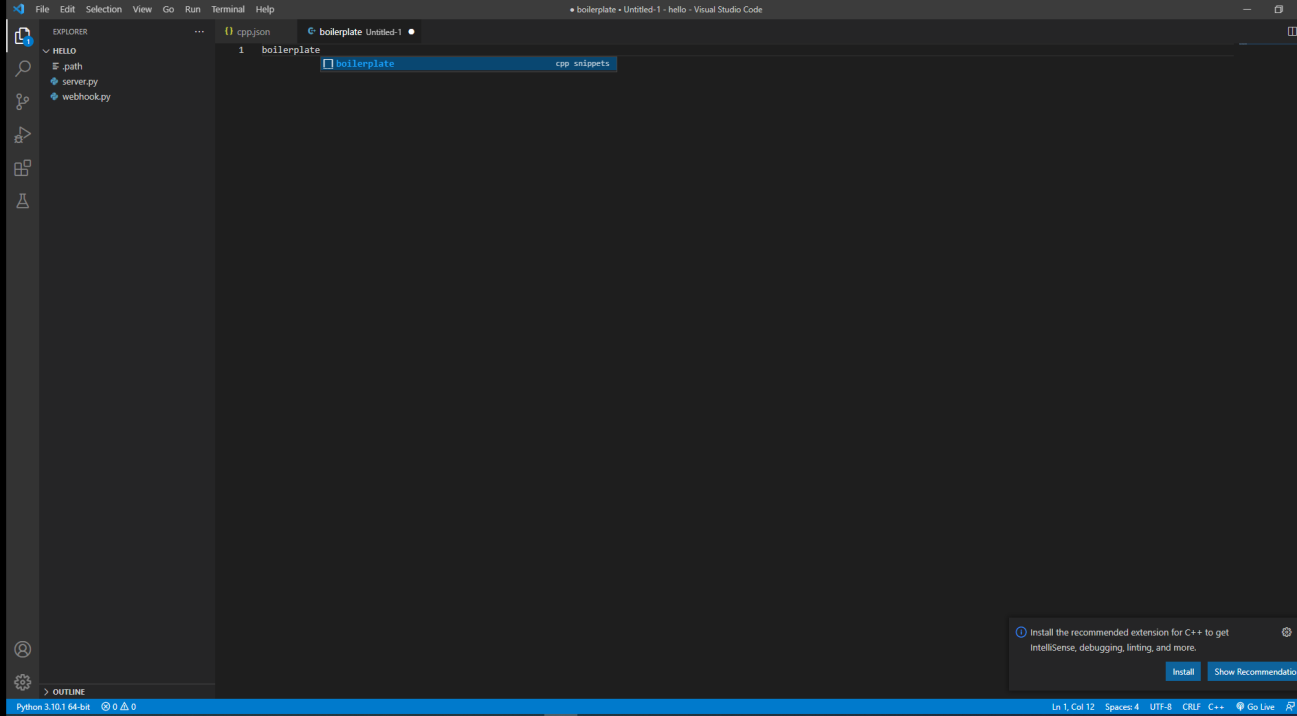
- After typing prefix, we will get our boilerplate code for that snippet. So in this way, we can use a basic boilerplate in everyday programming.
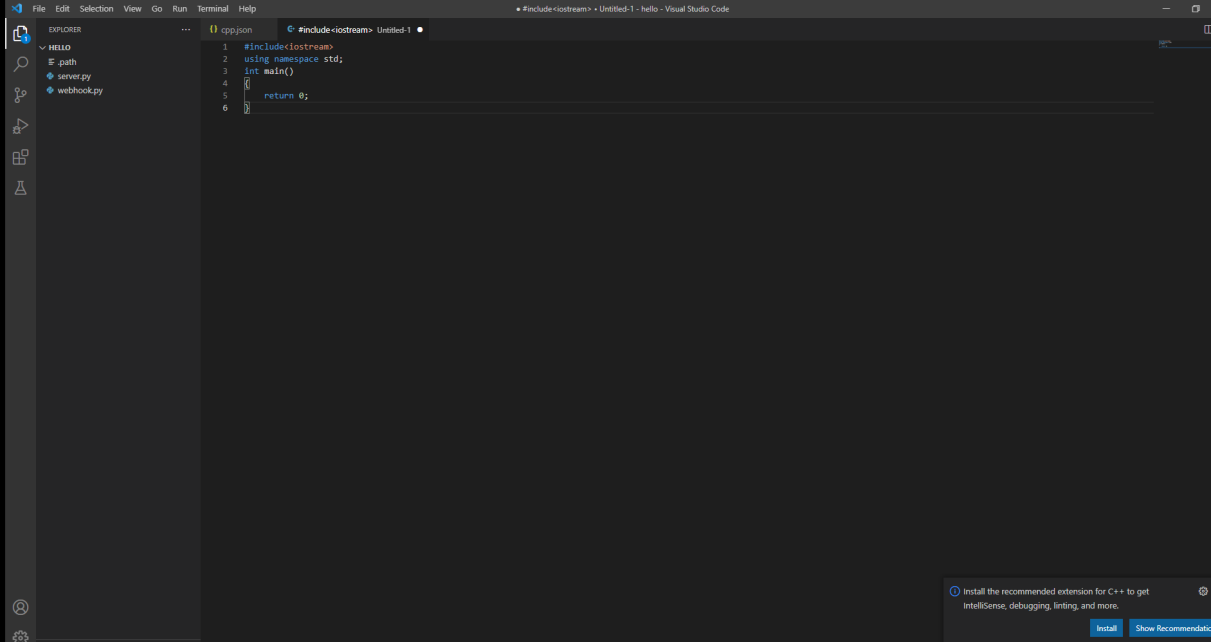
The Role of Boilerplate Code in Streamlining Development
In software development, boilerplate code is crucial in
streamlining the development process. By providing
pre-defined code snippets, standard code structures, and
programming templates, boilerplate code helps developers
write code more efficiently and reduces development
time.
Code snippets are reusable fragments of code that can be
inserted into a program to perform standard functions or
tasks. These snippets act as building blocks, allowing
developers to avoid repetitive coding and focus on the
unique aspects of their application. By providing a
collection of code snippets, boilerplate code enables
developers to quickly implement common functionalities
without starting from scratch.
Standard code structures are established patterns widely
accepted and used in software development. Following
industry best practices, these structures provide a
foundation for writing clean and maintainable code. With
boilerplate code, developers can easily access and
incorporate these standard code structures in their
projects, promoting code consistency and readability.
Boilerplate code serves as a programming template,
guiding developers in creating code that adheres to
specific guidelines and follows established conventions.
By providing a starting point for the development
process, boilerplate code helps developers avoid
reinventing the wheel and accelerates the overall coding
process.
The benefits of using boilerplate code in software
development are numerous. By reducing the time spent
writing repetitive code, developers can focus on
implementing unique features and solving complex
problems. Additionally, boilerplate code promotes
reusable code, allowing developers to leverage existing
code snippets and standard structures across multiple
projects, improving efficiency and maintainability.
Furthermore, boilerplate code facilitates collaboration
among developers by establishing a typical code
structure and set of conventions. This ensures that all
team members are on the same page and can easily
understand and work with each other's code, promoting
seamless integration and teamwork.
Example of a Common Boilerplate Code Structure
| Language | Code Structure |
|---|---|
| JavaScript | function myFunction() { // Function body } |
| Python | def my_function(): # Function body |
As demonstrated in the example, boilerplate code
provides a standard structure for defining functions in
different programming languages. This allows developers to quickly create function
templates and focus on implementing the logic specific
to their application.
Overall, the use of boilerplate code in software
development can greatly enhance productivity, code
quality, and collaboration among development teams. By
leveraging pre-defined code snippets, standard code
structures, and programming templates, developers can
streamline their workflow and deliver high-quality
applications more efficiently.
Common Examples of Boilerplate Code
In this section, we will explore some common boilerplate code examples frequently encountered in various programming languages. Understanding these examples will help developers gain a deeper insight into the nature and purpose of boilerplate code in coding scenarios.
1. Boilerplate Code in Java
Java, one of the most widely used programming languages,
often involves boilerplate code to define class
structures and handle exceptions. A common example is
the following snippet:
public class MyClass {
private int myVariable;
public MyClass(int variable) {
this.myVariable = variable;
}
public void doSomething() {
// Code implementation
}
}
2. Boilerplate Code in C++
C++ also utilizes boilerplate code in various scenarios.
A typical example includes
#include < iostream >
using namespace std;
int main() {
// Code implementation
return 0;
}
These examples highlight how boilerplate code appears in different programming languages, providing a foundation for developers to build upon and customize according to their specific requirements. By incorporating these pre-defined structures, developers can streamline their coding process and focus on implementing business logic and unique functionalities.
| Programming Language | Sample Boilerplate Code |
|---|---|
| Java |
public class MyClass {
private int myVariable; public MyClass(int variable) { this.myVariable = variable; } public void doSomething() { // Code implementation } } |
| C++ |
#include < iostream >
using namespace std; int main() { // Code implementation return 0; } |
What are Boilerplate Code Languages?
Boilerplate code is crucial in streamlining the
development process and enhancing coding efficiency in
programming. When it comes to boilerplate code, certain
programming languages, like Java, stand out for their
built-in boilerplate code structures. Java, an
object-oriented programming language, employs
boilerplate code extensively to provide reusable
templates and code patterns.
So, what exactly is boilerplate language? In simple
terms, it refers to the predefined code structures and
patterns that programmers commonly use as a starting
point for their projects. These code templates, often
implemented in programming languages like Java, help
developers accomplish repetitive or common tasks.
But what makes Java a notable example of a language with
boilerplate code? In Java, specific features like
annotations, getters and setters, and exception handling
require developers to write repetitive code segments for
every class. While these code segments are necessary for
the proper functioning of the program, they can be
time-consuming and monotonous to write. As a result,
Java introduced boilerplate code constructs to reduce
the need to write repetitive code manually.
Java's boilerplate code structures enable programmers to
automate the generation of commonly used code snippets,
reducing errors and saving valuable development time.
For instance, Java frameworks like Spring use
annotations that help generate boilerplate code for
various functionalities, such as dependency injection,
database connectivity, and REST API development.
By leveraging boilerplate language constructs in Java,
developers can focus more on implementing business logic
and addressing unique aspects of their projects instead
of repeatedly writing mundane code segments. This
significantly improves coding efficiency and accelerates
the development process, allowing developers to create
robust and feature-rich applications more swiftly.
In conclusion, boilerplate language, especially in
programming languages like Java, offers significant
benefits regarding code reusability, standardization,
and time-saving. By utilizing boilerplate code
structures, developers can streamline their development
workflow, minimize code duplication, and focus on
delivering high-quality
software solutions.
Benefits of Using Boilerplate Code
Boilerplate code plays a crucial role in software development, offering a range of benefits that enhance efficiency and productivity. By incorporating programming templates and reusable code fragments, developers can leverage boilerplate code to their advantage.
Promoting Code Reusability
One key advantage of boilerplate code is its ability to promote code reusability. By defining default code structures and patterns, developers can reuse well-tested code snippets across different projects, saving time and effort.
Saving Time with Default Code Structures
Boilerplate code provides default code structures that
expedite development. By offering pre-defined templates
for common tasks and algorithms, developers can bypass
repetitive code writing and focus on implementing
project-specific logic.
"Boilerplate code saves developers from reinventing the
wheel for common programming scenarios, allowing them to
tackle more complex challenges."
Programming Shortcuts
With boilerplate code, developers have access to time-saving programming shortcuts. They can utilize pre-built code patterns and snippets to quickly implement commonly used functionality, reducing the time spent writing code from scratch.
Code Maintenance Considerations
While boilerplate code offers numerous benefits, it's
important to consider the maintenance aspect.
Maintaining and updating boilerplate code becomes
crucial as projects evolve to ensure consistency and
compatibility across the codebase.
"Regularly reviewing and updating boilerplate code helps
prevent compatibility issues and ensures optimal
performance."
Furthermore, excessive use of boilerplate code can lead
to bloated codebases and reduce code readability. It's
essential to strike a balance and use boilerplate code
judiciously, focusing on providing value and improving
development efficiency.
Best Practices for Writing Boilerplate Code
When it comes to writing boilerplate code, following best practices can greatly enhance the efficiency and maintainability of your software development projects. Here are some key recommendations to remember:
- Create Reusable Code Snippets: One of the main purposes of boilerplate code is to provide reusable patterns that can be easily incorporated into different projects. Make sure to write code snippets that are modular, well-structured, and easily adaptable. This will allow you to save time and effort by reusing code across multiple projects.
- Select Appropriate Programming Templates: Choose programming templates that align with the specific requirements of your project. By using well-designed and widely accepted templates, you can ensure compatibility and reduce the likelihood of errors or conflicts. Be aware of specific coding conventions or standards in your chosen programming language.
- Avoid Unnecessary Code Duplication: While boilerplate code can be a time-saver, excessive duplication can lead to code bloat and decreased maintainability. As you write boilerplate code, eliminate unnecessary redundancy and streamline your code to be concise and efficient.
- Document Your Boilerplate Code: Clear documentation is essential for any boilerplate code. Provide comments and explanations within your code to help other developers understand its purpose and usage. This will facilitate collaboration and make it easier for future developers to modify or extend your code.
- Prioritize Code Readability:Boilerplate code should be readable and self-explanatory. Use meaningful variable and function names, follow consistent coding conventions, and use proper indentation to improve code readability. This will make it easier for yourself and others to understand and maintain the code in the long run.
Following these best practices will help you write effective boilerplate code that saves time, ensures code consistency, and enhances the overall quality of your software projects.
Overcoming Challenges with Boilerplate Code
Developers often encounter challenges and potential issues when working with boilerplate code. These challenges arise due to the repetitive nature of boilerplate code, which can lead to code duplication, increased maintenance effort, and decreased code readability. However, by implementing certain strategies and techniques, developers can overcome these challenges and make the most of boilerplate code.
Effective Management and Organization:
One of the key challenges with boilerplate code is managing and organizing it effectively. As projects grow in complexity and size, boilerplate code also increases. To overcome this challenge, developers can:
- Create a dedicated folder or directory for boilerplate code and ensure it is easily accessible by the entire development team.
- Use a version control system to track changes and manage the evolution of boilerplate code.
- Implement a naming convention for boilerplate code files and snippets to enable easy searching and identification.
By following these practices, developers can ensure that boilerplate code is well-organized and can be efficiently reused throughout various projects.
Minimizing Negative Impact on Code Quality
Boilerplate code, if used excessively, can harm code quality and maintainability. To mitigate this, developers can:
- Regularly review and refactor boilerplate code to eliminate redundancy and improve its clarity.
- Document the purpose and usage of boilerplate code to aid other developers in understanding its intended functionality.
- Ensure that boilerplate code follows established coding standards and best practices.
By taking these steps, developers can reduce the negative impact of boilerplate code on code quality and make it more maintainable in the long run.
Code Reusability and Customization
Another challenge with boilerplate code are balancing code reusability and customization. Boilerplate code is often designed to provide a foundation for specific tasks or functionalities. However, developers may need to customize it to fit their specific requirements. To address this challenge, developers can:
- Create reusable code snippets or modules that can be easily customized without modifying the original boilerplate code.
- Use configuration files or parameters to make boilerplate code more flexible and adaptable.
- Implement clear documentation and comments within boilerplate code to guide developers on customization options.
By striking the right balance between code reusability
and customization, developers can maximize the benefits
of boilerplate code while still catering to
project-specific requirements.
While boilerplate code poses challenges, it can be
effectively managed and utilized to streamline
development and improve code efficiency. By implementing
proper management practices, minimizing negative impacts
on code quality, and focusing on code reusability and
customization, developers can overcome these challenges
and harness the full potential of boilerplate code in
their software development projects.
Conclusion
In conclusion, boilerplate code plays a crucial role in
software development, offering a streamlined approach to
coding. Developers can expedite coding and enhance
productivity by providing reusable code fragments and
programming templates. Boilerplate code eliminates the
need for repetitive coding tasks, allowing programmers
to focus on the core functionality of their software.
Developers can create more efficient and maintainable
code by utilizing boilerplate code effectively. It acts
as a foundation that eliminates the need to reinvent the
wheel with every new project, leading to optimized
development cycles and reduced time-to-market. Whether
in the form of default code structures or code snippets,
boilerplate code promotes code reusability, consistency,
and code maintenance.
In software development, time is of the essence, and
boilerplate code is a valuable time-saving tool. It
enables programmers to access pre-defined code patterns,
reducing coding complexities and providing shortcuts to
achieve desired functionalities. Furthermore,
programming templates allow developers to kickstart
their projects with a solid foundation, improving code
quality and scalability.
By embracing boilerplate code, developers can leverage
reusable code fragments and template code to streamline
their software development processes. It offers a
standardized approach to programming, enhancing
collaboration and code readability. Ultimately, by
adopting best practices for writing and managing
boilerplate code, developers can optimize their
workflow, increase efficiency, and deliver high-quality
software.
FAQ
What is boilerplate code?
Boilerplate code refers to sections of code that are repeated in multiple places with little or no modification. It consists of common code patterns or standard code structures used as a starting point or a foundation for developing specific functionalities. Boilerplate code helps streamline development by providing reusable code fragments and shortcuts.
Why is boilerplate code necessary?
Boilerplate code is necessary because it allows developers to write code more efficiently. Developers can save time and effort writing repetitive code by using pre-defined code snippets or templates for commonly performed tasks. Boilerplate code also promotes code reusability, making it easier to maintain and update applications in the long run.
How does boilerplate code relate to programming templates and common code patterns?
Boilerplate code is often similar to programming templates, which provide a standardized structure for solving specific coding problems. Boilerplate code includes common patterns like initializing variables, handling exceptions, and setting up database connections. These patterns can be reused across different projects, improving code consistency and reducing the likelihood of errors.
What are some common examples of boilerplate code in different programming languages?
Boilerplate code can vary depending on the programming language or framework used. In Java, for example, boilerplate code may include method signatures, import statements, and getters/setters. In C++, boilerplate code can involve class declarations, constructor definitions, and operator overloading. Other examples of boilerplate code can be found in HTML, CSS, JavaScript, and various other programming languages.
How does boilerplate language relate to programming?
Boilerplate language refers to the built-in code
structures and frameworks within specific programming
languages.
For instance, Java has a rich set of boilerplate code
that enables developers to define classes, interfaces,
and methods using standard templates. These
language-specific patterns help ensure code consistency,
enhance productivity, and facilitate development.
What are the benefits of using boilerplate code?
Using boilerplate code offers several benefits in software development. It promotes code reusability, allowing developers to save time by leveraging existing code patterns. Boilerplate code provides default code structures, reducing the need to write repetitive code from scratch. It also acts as a programming shortcut, enabling developers to focus on the unique aspects of their application rather than reinventing the wheel.
What are some best practices for writing boilerplate code?
When writing boilerplate code, creating reusable code
snippets, selecting appropriate programming templates,
and ensuring code readability is essential.
Documentation plays a vital role in helping other
developers understand the purpose and usage of
boilerplate code.
Additionally, avoiding unnecessary code duplication and
maintaining consistency across codebases are essential
best practices for writing effective boilerplate code.
What are some challenges with boilerplate code, and how can they be overcome?
One challenge with boilerplate code is the potential increase in code complexity and maintenance effort. To address this, developers can effectively organize and manage their boilerplate code using modular code structures and code generation tools. It is also essential to strike a balance and avoid excessive boilerplate code, which could make the codebase harder to understand and maintain in the long run.

